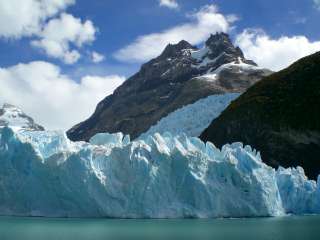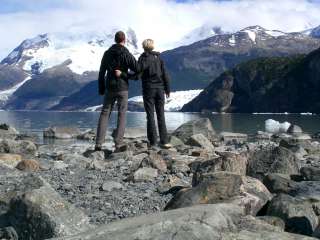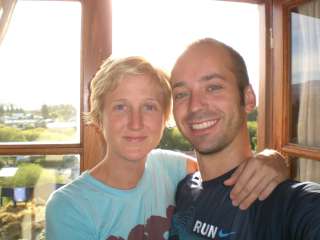 The orientation at our wonderful hostel boiled down to a few options: take the boat ride one day and hike on Perito Moreno glacier the next, unless you want to cheap out and just look at it, because that is what you do in El Calafate. There is only one tour company for the Glacier National Park and one ridiculously high price for each tour. We did as they instructed and signed up for both.
The orientation at our wonderful hostel boiled down to a few options: take the boat ride one day and hike on Perito Moreno glacier the next, unless you want to cheap out and just look at it, because that is what you do in El Calafate. There is only one tour company for the Glacier National Park and one ridiculously high price for each tour. We did as they instructed and signed up for both.
Upon boarding the boat the first day we were disappointed to find we  had to sit in the middle, far from the windows of the enormous catamaran, but we ended up spending most of our time on deck, trying to shield ourselves from the biting wind while exposing ourselves to as much sun as possible. A frenzy ensued on desk as we approached the first iceberg. Everyone suddenly became paparazzi, pushing and shoving for a prime location and lighting up the iceberg with camera flashes. A single-hulled vessel would surely have tipped over as all the passengers lurched to one side. Fortunately, everyone soon realized that the little chunk of washed up ice was hardly newsworthy, even for the tabloids or their travel blogs. We later circled dozens of larger icebergs with glassy walls, dripping arches and cobalt blue crevices.
had to sit in the middle, far from the windows of the enormous catamaran, but we ended up spending most of our time on deck, trying to shield ourselves from the biting wind while exposing ourselves to as much sun as possible. A frenzy ensued on desk as we approached the first iceberg. Everyone suddenly became paparazzi, pushing and shoving for a prime location and lighting up the iceberg with camera flashes. A single-hulled vessel would surely have tipped over as all the passengers lurched to one side. Fortunately, everyone soon realized that the little chunk of washed up ice was hardly newsworthy, even for the tabloids or their travel blogs. We later circled dozens of larger icebergs with glassy walls, dripping arches and cobalt blue crevices.
 After some other travels, we returned to El Calafate for our short trek on the glacier. Donning every warm piece of clothing we have, along with the requisite crampons, we followed our guide up ridges and over crevices. We stood over holes to peer deep into the ice sheet and tried not to drop our camera while trying to take pictures through thick cotton gloves. Janet dropped the camera. And nearly ripped her pants with the crampons. Near the end, we climbed over a ridge to find a table, a dozen glasses and a bottle of scotch. The guides chopped ice from the glacier to further chill our scotch, which we enjoyed standing on the glaciers in our crampons.
After some other travels, we returned to El Calafate for our short trek on the glacier. Donning every warm piece of clothing we have, along with the requisite crampons, we followed our guide up ridges and over crevices. We stood over holes to peer deep into the ice sheet and tried not to drop our camera while trying to take pictures through thick cotton gloves. Janet dropped the camera. And nearly ripped her pants with the crampons. Near the end, we climbed over a ridge to find a table, a dozen glasses and a bottle of scotch. The guides chopped ice from the glacier to further chill our scotch, which we enjoyed standing on the glaciers in our crampons.
Shortly afterward, we saw what we had longed for: a part of the 40 meter ice face broke away, fell into the lake, smashed into tiny pieces and created an enormous wave, which we watched propagate across the lake. One sign stated that the falling ice can throw smaller lethal chucks of ice hundreds of meters. 32 people died between 1968 and 1988.
With the rate that glaciers are melting—having added tons of carbon dioxide to the atmosphere with our plane travel—I feel fortunate to have experienced them.


 But now we are here and the living is easy. We are rapidly learning/re-learning Spanish and consuming wine, both things that we’ve been anxiously looking forward to. Three evenings in a row, I’ve had steak for supper and I think that perhaps three might be the limit. Not so with wine, though. I can’t get enough of it or of the view we have from our room in the hostel, America Del Sur, a.k.a. the best hostel in the world. This town is perched on the edge of Lake Argentina which borders a few glaciers in the national park; I can’t see them from the window but the lake and the Andes make a glorious view at any time of day. We haven’t seen the southern cross constellation yet but I’m keeping my eyes peeled. Meanwhile, our jet lag is wearing off, our exercise is increasing, we’re breathing lots of fresh, cool air and are starting to feel invigorated with some the thought of some brilliant hiking in our near future.
But now we are here and the living is easy. We are rapidly learning/re-learning Spanish and consuming wine, both things that we’ve been anxiously looking forward to. Three evenings in a row, I’ve had steak for supper and I think that perhaps three might be the limit. Not so with wine, though. I can’t get enough of it or of the view we have from our room in the hostel, America Del Sur, a.k.a. the best hostel in the world. This town is perched on the edge of Lake Argentina which borders a few glaciers in the national park; I can’t see them from the window but the lake and the Andes make a glorious view at any time of day. We haven’t seen the southern cross constellation yet but I’m keeping my eyes peeled. Meanwhile, our jet lag is wearing off, our exercise is increasing, we’re breathing lots of fresh, cool air and are starting to feel invigorated with some the thought of some brilliant hiking in our near future.